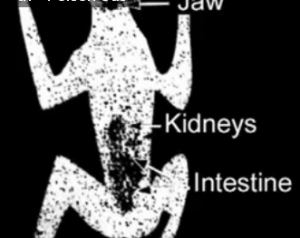 Ok, so we all now know that mercury get’s into the body through the lungs and the intestines. But what happens then? Fortunately our bodies have evolved alongside small amounts of natural mercury from volcanoes and geological deposits, which means that we have a built in mechanism to actually get it out of our bodies (unlike some modern manmade chemicals!). The liver, the kidney’s and intestines are all set up for small amounts of mercury processing. But we’re probably talking about small occasional amounts. Those of us with mercury amalgam in our mouths have constant daily exposure, in varying degrees, so over time this means lot’s of mercury getting in to the body. And if it’s too much for our elimination organ’s to handle, it get’s stuck in the body (like the pictures of the sheep and the monkey in the last post).
Ok, so we all now know that mercury get’s into the body through the lungs and the intestines. But what happens then? Fortunately our bodies have evolved alongside small amounts of natural mercury from volcanoes and geological deposits, which means that we have a built in mechanism to actually get it out of our bodies (unlike some modern manmade chemicals!). The liver, the kidney’s and intestines are all set up for small amounts of mercury processing. But we’re probably talking about small occasional amounts. Those of us with mercury amalgam in our mouths have constant daily exposure, in varying degrees, so over time this means lot’s of mercury getting in to the body. And if it’s too much for our elimination organ’s to handle, it get’s stuck in the body (like the pictures of the sheep and the monkey in the last post).
Mercury has an affinity for the brain & central nervous system, the liver, the kidney’s, our hormone-producing glands, the digestive tract and even the heart, and this is where you will find the highest concentrations of mercury in the body. But ultimately mercury can deposit in any body tissue. So what happens when mercury builds up in the body? Well, a short list is that it can suppress the immune system, deactivate crucial enzymes, inhibit the production of hormones, poison nerves, weaken the kidneys and burden the liver. Anywhere it goes it will damage cells and disrupt metabolic activities. For some this might stay sub clinical and without symptoms, for others it can lead to illness. And lot’s of illnesses & symptoms may have a mercury link, including insomnia, anxiety, depression, chronic fatigue syndrome, fibromyalgia, hypothyroidism, GI inflammation, auto-immune conditions and even skin problems. And that’s just the short list. The amazing Consumer’s for Dental Choice in the US have put out an extensive list of symptoms here (look under Scientific Facts: Symptoms of Mercury Poisoning).
Over time we’ll look more closely at how mercury can affect each of our body systems, but I guess for now, the point is, mercury get’s in, stay’s in and does damage!


